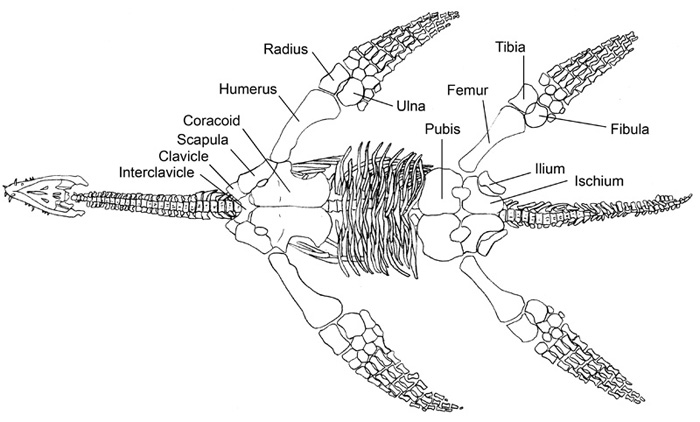Recent plesiosaur papers – a round up
So far, 2008 has seen a healthy number of new papers on plesiosaurs and a few new taxa too. Way back in February, Druckenmiller and Russell (2008a) introduced Nichollsia borealis, a plesiosaur of uncertain affinity, based on a beautifully preserved specimen from Alberta, Canada. More recently, Druckenmiller and Russell (2008b) published a large scale cladistic analysis of plesiosauria to try and make sense of plesiosaur relationships, especially the affinities of Leptocleidus and Nichollsia – this is a substantial piece of work. Both papers stem directly from Druckenmiller’s PhD thesis.
Sato and Wu (2008) erected a new taxon Borealonectes russelli, a pliosaur they identify as a rhomaleosaurid, based on a skull and partial postcranium from the Canadian Arctic Archipelago. rhomaleosaurids also recieved treatment from Smith and Dyke (2008) who described the skull of Rhomaleosaurus cramptoni – the holotype of the family. They also present a full body reconstruction of the 7m long genus, and a cladistic analysis dedicated to pliosaurs.
Long necks received attention from Zammit et al. (2008) who investigated the flexibility of an elasmosaurid cervical column, confirming the common presumption that swan-like postures were impossible in beasts such as Elasmosaurus. Bardet et al. (2008) described a partial plesiosaur skeleton from Asturias, helping to elucidate plesiosaur diversity in the Pliensbachian and presenting a rare specimen from Spain.
Finally (for now, I may have overlooked one or two papers), Smith (2008) presented an overview of plesiosaurs aimed at a popular audience. It covers basic aspects of the anatomy and biology of plesiosaurs. I hope this article will fill the void present between technical papers and children’s books and help people ‘get into’ the scientific literature, which can be quite daunting otherwise.

Plesiosaur anatomy – Figure 1 from Smith (2008)
References –
Bardet, N., M.., Fernández, J. C. García-Ramos, Z. P. Suberbiola, L. Piñuela, J. I. Ruiz-Omeñaca, and P. Vincent. 2008. A juvenile plesiosaur from the Pliensbachian (Lower Jurassic) of Asturias, Spain. Journal of Vertebrate Paleontology, 28, 258-263.
Druckenmiller, P. S. and Russell, A. P. 2008a. Skeletal anatomy of an exceptionally complete specimen of a new genus of plesiosaur from the Early Cretaceous (Early Albian) of Northeastern Alberta, Canada. Palaeontolgraphica, 283, 1-33.
Druckenmiller, P. S. and Russell, A. P. 2008b. A phylogeny of Plesiosauria (Sauropterygia) and its bearing on the systematic status of Leptocleidus Andrews, 1922. Zootaxa, 1863, 120pp.
Sato, T. and Wu, X-C. 2008. A new Jurassic pliosaur from Melville Island, Canadian Arctic Archipelago. Canadian Journal of Earth Science, 45, 303-320.
Smith, A. S. 2008. Fossils explained 54: plesiosaurs. Geology Today. 24, (2), 71-75.
Smith, A.S. and Dyke, G.J. 2008. The skull of the giant predatory pliosaur Rhomaleosaurus cramptoni: implications for plesiosaur phylogenetics. Naturwissenschaften, 95, 975-980.
Zammit, M.; Daniels, C. B. and Kear, B. P. 2008. Elasmosaur (Reptilia: Sauropterygia) neck flexibility: Implications for feeding strategies. Comparative Biochemistry and Physiology, Part A 150, 124–130
